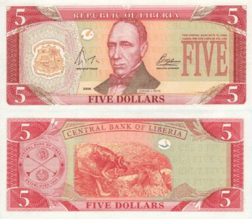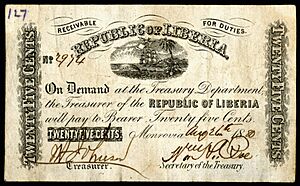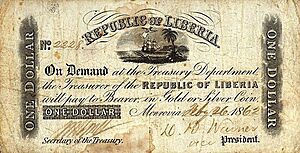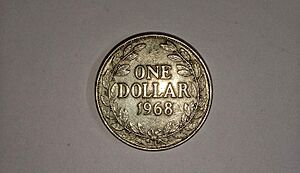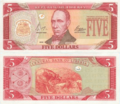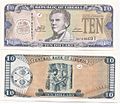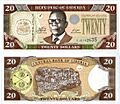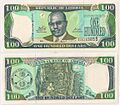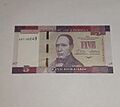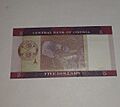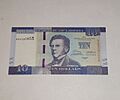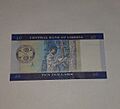Liberian dollar facts for kids
Quick facts for kids Liberian dollar |
|||
|---|---|---|---|
|
|||
| ISO 4217 Code | LRD | ||
| User(s) | |||
| Inflation | 7.7% | ||
| Source | The World Factbook , 2015 est. | ||
| Subunit | |||
| 1⁄100 | cent | ||
| Symbol | $, L$, LD$ | ||
| Coins | 5¢, 10¢, 25¢, 50¢, L$1, L$5, L$10 | ||
| Banknotes | L$5, L$10, L$20, L$50, L$100, L$500, L$1,000 | ||
The Liberian dollar (currency code LRD) is the money used in Liberia. It has been the official currency since 1943. Before that, it was also used from 1847 to 1907.
You can usually spot the Liberian dollar by the $. Sometimes, it's also shown as L$ or LD$. This helps people tell it apart from other currencies also called "dollar." Each Liberian dollar is made up of 100 cents.
Contents
History of the Liberian Dollar
Early Use of the Dollar
The first Liberian dollar was created in 1847. At first, it had the same value as the US dollar. Both currencies were used in Liberia until 1907. After that, Liberia started using the British West African pound, which was linked to the British pound.
First Coins
In 1847 and 1862, Liberia only made copper coins for 1 and 2 cents. These were the only Liberian coins for many years. Then, in 1896, a full set of coins was introduced. These included 1, 2, 10, 25, and 50 cents. The last of these early coins were made in 1906.
The Dollar Returns
The US dollar replaced the British West African pound in Liberia in 1935. A few years later, in 1937, Liberia began making its own coins again. These new Liberian coins were used alongside US currency.
After a change in government in 1980, there was a shortage of US dollars in Liberia. To help with this, Liberia started making special seven-sided $5 coins. These coins were the same size and weight as the one-dollar coin. This design helped keep money within the country.
In the late 1980s, new $5 banknotes were introduced. These notes were designed to look like the US dollar. During a civil war (1990-2004), the design of the notes was changed. This was done to make sure that money stolen from the Central Bank could not be used. This created two different money zones. New "Liberty" notes were used in areas controlled by the government. Older "J. J. Roberts" notes were used in other areas. After 1995, the "J. J. Roberts" notes became more widely accepted in many places.
After a new government was elected in 1997, a new series of banknotes was introduced in 2000.
Later Coins
In 1937, Liberia issued coins for 1⁄2, 1, and 2 cents. More coins were added in 1960, including 1, 5, 10, 25, and 50 cents. A $1 coin was introduced the next year. Five-dollar coins were also made in 1982 and 1985. Since the 1970s, many special collector coins have been made. These coins feature different designs like US Presidents or animals. Their values range from $1 to $2500.
Banknotes Today
In 1989, $5 notes with the picture of J. J. Roberts were introduced. These were called "J. J." notes. Later, in 1991, notes with Liberia's national symbol were issued. These were known as "Liberty" notes.
On March 29, 2000, the Central Bank of Liberia introduced a new "unified" currency. The new banknotes each show a picture of a former Liberian president. These notes are still used today. They had a small update in 2003 with new dates and signatures.
On July 27, 2016, the Central Bank of Liberia announced new banknotes with better security features. A new L$500 banknote was also added to this series. These new notes were released on October 6, 2016.
More recently, on November 17, 2021, the Central Bank announced another new series of banknotes. The L$5 and L$10 banknotes were replaced by coins. A brand new L$1000 banknote was also introduced.
See also
- Central Bank of Liberia
- Economy of Liberia
Images for kids


